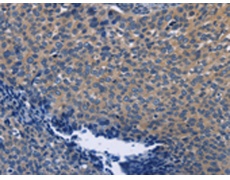|
Background: |
Synaptotagmin XVII (SytXVII), also known as Synaptotagmin-17 (SYT17) or Protein B/K, is a 474 amino acid peripheral membrane protein that belongs to the Synaptotagmin family and contains two C2 domains. While expressed abundantly in brain (frontal and temporal lobes, hippocampus, hypothalamus, amygdala, substantia nigra and pituitary), kidney and prostate, Synaptotagmin XVII is also expressed in fetal brain, kidney and lung. The gene that encodes Synaptotagmin XVII contains 100,082 bases and maps to human chromosome 16p12.3. Encoding over 900 genes and consisting of approximately 90 million base pairs, chromosome 16 makes up nearly 3% of the human genome and is associated with a variety of genetic disorders, such as giant axonal neuropathy, Rubinstein-Taybi syndrome and Crohn's disease. An association with systemic lupus erythematosis and a number of other autoimmune disorders with the pericentromeric region of chromosome 16 has led to the identification of SLC5A11 as a potential autoimmune modifier. |
|
Applications: |
ELISA, WB, IHC |
|
Name of antibody: |
SYT17 |
|
Immunogen: |
Fusion protein of human SYT17 |
|
Full name: |
synaptotagmin XVII |
|
Synonyms: |
sytXVII |
|
SwissProt: |
Q9BSW7 |
|
ELISA Recommended dilution: |
1000-5000 |
|
IHC positive control: |
Human cervical cancer and human colon cancer |
|
IHC Recommend dilution: |
50-200 |
|
WB Predicted band size: |
54 kDa |
|
WB Positive control: |
Mouse kidney tissue |
|
WB Recommended dilution: |
200-1000 |


 購物車
購物車 幫助
幫助
 021-54845833/15800441009
021-54845833/15800441009
